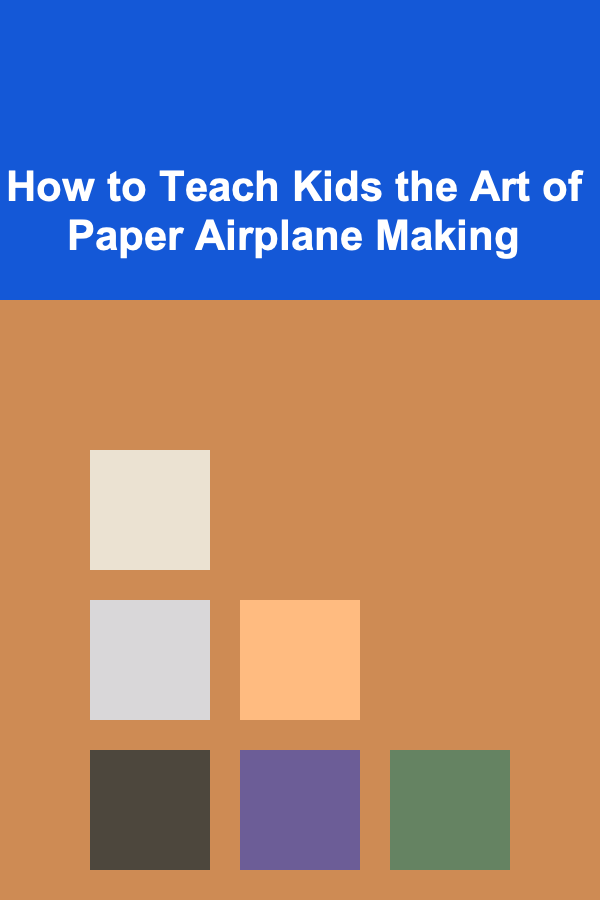
How to Teach Kids the Art of Paper Airplane Making
ebook include PDF & Audio bundle (Micro Guide)
$12.99$7.99
Limited Time Offer! Order within the next:

Paper airplanes are more than just a fun pastime or a simple craft project---they're an engaging way to introduce children to a wide range of scientific principles, from aerodynamics to problem-solving skills. The art of making paper airplanes is a perfect balance of creativity, engineering, and play, making it an ideal activity for kids of all ages. By teaching children how to make paper airplanes, you not only provide them with an enjoyable activity but also spark their curiosity about the world of science and mechanics.
In this article, we'll explore how to teach kids the art of paper airplane making, the benefits of doing so, and tips to make the process enjoyable and educational. Whether you're a parent, educator, or mentor, this guide will provide a detailed approach to making paper airplanes both fun and informative for kids.
The Appeal of Paper Airplanes
Before delving into how to teach kids to make paper airplanes, it's essential to understand why this activity is so appealing. First and foremost, it's simple and requires minimal materials. A single sheet of paper and a little creativity can yield hours of entertainment. Additionally, paper airplanes are inherently interactive. Kids can test their designs by flying them, comparing results, and tweaking their designs for better performance.
Moreover, paper airplanes are an excellent introduction to basic concepts of physics and engineering. They provide a hands-on way for kids to learn about principles such as lift, thrust, drag, and gravity, all of which are fundamental to the field of aerodynamics.
Finally, creating and flying paper airplanes can spark a child's imagination. By experimenting with different folds, designs, and modifications, they can explore the concept of trial and error, which is an important life skill. It encourages persistence and fosters a sense of achievement when they improve their plane's performance.
Preparing for the Activity: What You'll Need
Materials
Making paper airplanes doesn't require much preparation, but it's helpful to have everything in place before you begin the lesson. The materials needed are basic and easy to access:
- Paper: Printer paper (8.5 x 11 inches) is ideal, though you can experiment with different sizes and types of paper, such as colored paper, recycled paper, or even paper with designs.
- Pens or Markers: For decorating the planes (optional but fun).
- Ruler: For precise measurements if you want to create a more complex plane.
- Scissors: Only needed for specific modifications (optional).
- Tape or Stickers: To customize or enhance the plane's design (optional).
These materials are simple enough to gather, and chances are you already have them at home or in the classroom. The focus is on creativity and exploration rather than requiring specialized equipment.
Space and Environment
You don't need a large area for making paper airplanes, but having a clear, open space to fly the planes will make the activity more enjoyable. Consider the following:
- Indoor Space: A large table or a flat surface to work on is ideal. Ensure that the floor or surrounding area is clear of obstacles so that kids can watch their airplanes soar.
- Outdoor Space: If you have a yard or an open park nearby, it could be a great opportunity for the kids to test their planes in a larger area. Just make sure there's no wind to interfere with their designs.
Teaching the Basics of Paper Airplane Making
The first step in teaching kids how to make paper airplanes is showing them the basics. This involves introducing them to the fundamental folds and the concept of a simple airplane design. Start with one of the simplest airplane designs to ensure they grasp the basics before progressing to more advanced techniques.
Step-by-Step Instructions for a Basic Paper Airplane
- Start with a Sheet of Paper: Place the paper on a flat surface, ensuring it's oriented with the shorter side horizontally.
- Fold the Paper in Half Lengthwise: Fold the paper in half, lining up the edges precisely. This step is critical as it helps align the plane's symmetry. After folding, unfold the paper to reveal a crease in the center.
- Create the First Folds: Take the top two corners of the paper and fold them towards the center crease. You should now have a triangle shape at the top of the paper.
- Make a Second Set of Folds: Fold the two newly created edges towards the center crease again. This step will make the plane's nose more pointed.
- Fold the Plane in Half: Fold the entire plane in half along the original crease, with the triangular folds facing out.
- Create the Wings: Fold each side of the paper down so that the edges line up with the bottom of the plane's body. Make sure both wings are even, as this will affect the plane's flight.
- Final Adjustments: Gently unfold the wings slightly to give the plane a good wing shape, then add small creases at the back of the wings to make them stiffer.
Now that you've demonstrated how to make the basic paper airplane, you can encourage the kids to give it a try themselves. Allow them to explore their creativity by adding their designs, such as drawing patterns, cutting the wings for different shapes, or even experimenting with the folds.
Encouraging Creativity and Experimentation
Once the children understand how to make a basic paper airplane, it's time to encourage them to experiment. This is a great opportunity to explore the concept of trial and error, where they can test different designs and modifications to see how these affect the plane's flight performance.
Customizing the Design
After the basic plane is built, kids can add their own flair to it. Here are a few ideas for customization:
- Decorate the Plane: Allow the children to decorate their planes with colorful markers, stickers, or stamps. This adds a personal touch and makes the activity more engaging.
- Modify the Shape: Encourage the kids to experiment with the size and shape of the wings. Larger wings may make the plane fly slower, while smaller wings could make it faster.
- Adjust the Nose: Teach them how the nose of the plane affects its flight. A sharp nose can cut through the air, while a broader nose may slow the plane down.
- Try Different Folds: Explore variations in folding the plane to experiment with different aerodynamic effects.
Discussing Aerodynamics
As the kids start to modify their planes, take the opportunity to introduce them to basic concepts of aerodynamics. You don't need to go into deep scientific explanations---just simple ideas they can understand. For instance:
- Lift: Explain how the wings of the plane create lift by pushing the air down, allowing the plane to rise.
- Thrust: Describe how the force you give the plane when you throw it helps it move forward.
- Drag: Talk about how the plane's design and the air resistance it encounters can affect its speed.
- Gravity: Teach the concept that gravity pulls the plane down, and that's why it eventually lands.
These discussions can be informal but provide a foundation for scientific thinking.
Advanced Paper Airplane Designs
Once the children are comfortable with the basics, you can challenge them with more advanced designs. This not only makes the activity more interesting but also helps them understand the relationship between design and performance.
Here are a few examples of more complex paper airplane designs:
1. The Dart
A sharp, fast-flying paper airplane that requires precise folding. This design is great for kids who enjoy speed and competition.
2. The Glider
A slow, steady-flying plane with large wings. The glider emphasizes how wing size and shape affect flight duration.
3. The Hammerhead
A unique design where the nose of the plane is folded down to create a "hammerhead" shape. This design demonstrates how weight distribution affects the flight path.
4. The Seagull
An elegant plane that incorporates winglets (small upward folds at the tips of the wings) to reduce drag and increase stability.
As kids experiment with these more complex designs, encourage them to track their results, compare flight distances, and adjust their planes accordingly. This can help teach important lessons in observation, measurement, and the scientific method.
The Educational Benefits of Paper Airplane Making
While making paper airplanes may seem like a simple craft, the activity has a surprising number of educational benefits:
1. Understanding Basic Physics
Through the process of folding and flying, kids are introduced to key principles of physics such as gravity, lift, drag, and thrust. By making their own adjustments and observing the results, they begin to understand how these forces work in real life.
2. Developing Problem-Solving Skills
Designing and testing different types of paper airplanes teaches kids to think critically and experiment with solutions. If a plane doesn't fly well, they learn to troubleshoot and modify their design.
3. Encouraging Creativity
Paper airplane making allows kids to explore their creative side by experimenting with different shapes, colors, and designs. This fosters innovation and helps children learn to think outside the box.
4. Enhancing Fine Motor Skills
The folding process itself helps kids develop fine motor skills as they practice precision and attention to detail when folding paper.
5. Promoting Social Interaction
Making paper airplanes can be a group activity, which encourages social interaction and teamwork. Kids can work together to design the best plane, compete in challenges, and share their findings.
Conclusion
Teaching kids the art of paper airplane making is more than just a fun activity---it's a fantastic educational tool that introduces children to basic concepts of aerodynamics, problem-solving, and creativity. By starting with simple designs and progressively encouraging kids to experiment with modifications, you can help them develop a range of skills, from critical thinking to scientific inquiry.
Whether done in a classroom, at home, or as part of a group activity, paper airplanes offer a hands-on, interactive way for kids to learn and have fun at the same time. So, next time you're looking for an educational and engaging activity, grab a sheet of paper and let the skies be the limit!
Reading More From Our Other Websites
- [Home Staging 101] How to Stage a Bedroom for Maximum Relaxation and Comfort
- [Personal Care Tips 101] How to Use Mouthwash to Treat Mouth Sores and Ulcers
- [Home Staging 101] How to Stage Your Home for Virtual Tours
- [Home Family Activity 101] How to Host a Themed Dinner Night at Home
- [Organization Tip 101] How to Set Up a Cleaning Schedule That Works for You
- [Organization Tip 101] How to Use a Garden Planner App to Stay Organized
- [Stamp Making Tip 101] DIY Stamp Making: Essential Tools and Materials for Craft Lovers
- [Trail Running Tip 101] How to Prepare Your Body for Repeated Hill Sprints on Rocky Trail Sections
- [Home Security 101] How to Protect Your Home from Cybersecurity Threats
- [Home Party Planning 101] Best Ways to Plan a Home Party That's Both Comfortable and Socially Engaging

How To Engage with Local Philosophies and Worldviews
Read More
How to Store Bulbs and Tubers Properly for Future Planting
Read More
How to Optimize Your Supplement Use for Weight Loss
Read More
How To Apply Stoicism to Finding Joy in Simple Things
Read MoreHow to Build a Personalized Asset Allocation Tracker in Google Sheets
Read More
How to Plan a Sustainable and Eco-Friendly Travel Itinerary
Read MoreOther Products

How To Engage with Local Philosophies and Worldviews
Read More
How to Store Bulbs and Tubers Properly for Future Planting
Read More
How to Optimize Your Supplement Use for Weight Loss
Read More
How To Apply Stoicism to Finding Joy in Simple Things
Read MoreHow to Build a Personalized Asset Allocation Tracker in Google Sheets
Read More